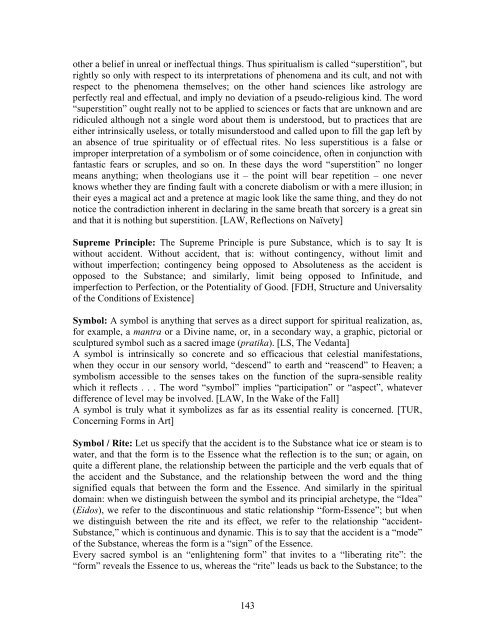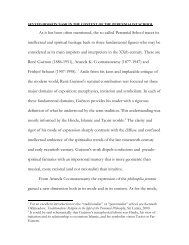glossary of terms used by frithjof schuon - Sophia Perennis
glossary of terms used by frithjof schuon - Sophia Perennis
glossary of terms used by frithjof schuon - Sophia Perennis
You also want an ePaper? Increase the reach of your titles
YUMPU automatically turns print PDFs into web optimized ePapers that Google loves.
other a belief in unreal or ineffectual things. Thus spiritualism is called “superstition”, but<br />
rightly so only with respect to its interpretations <strong>of</strong> phenomena and its cult, and not with<br />
respect to the phenomena themselves; on the other hand sciences like astrology are<br />
perfectly real and effectual, and imply no deviation <strong>of</strong> a pseudo-religious kind. The word<br />
“superstition” ought really not to be applied to sciences or facts that are unknown and are<br />
ridiculed although not a single word about them is understood, but to practices that are<br />
either intrinsically useless, or totally misunderstood and called upon to fill the gap left <strong>by</strong><br />
an absence <strong>of</strong> true spirituality or <strong>of</strong> effectual rites. No less superstitious is a false or<br />
improper interpretation <strong>of</strong> a symbolism or <strong>of</strong> some coincidence, <strong>of</strong>ten in conjunction with<br />
fantastic fears or scruples, and so on. In these days the word “superstition” no longer<br />
means anything; when theologians use it – the point will bear repetition – one never<br />
knows whether they are finding fault with a concrete diabolism or with a mere illusion; in<br />
their eyes a magical act and a pretence at magic look like the same thing, and they do not<br />
notice the contradiction inherent in declaring in the same breath that sorcery is a great sin<br />
and that it is nothing but superstition. [LAW, Reflections on Naïvety]<br />
Supreme Principle: The Supreme Principle is pure Substance, which is to say It is<br />
without accident. Without accident, that is: without contingency, without limit and<br />
without imperfection; contingency being opposed to Absoluteness as the accident is<br />
opposed to the Substance; and similarly, limit being opposed to Infinitude, and<br />
imperfection to Perfection, or the Potentiality <strong>of</strong> Good. [FDH, Structure and Universality<br />
<strong>of</strong> the Conditions <strong>of</strong> Existence]<br />
Symbol: A symbol is anything that serves as a direct support for spiritual realization, as,<br />
for example, a mantra or a Divine name, or, in a secondary way, a graphic, pictorial or<br />
sculptured symbol such as a sacred image (pratika). [LS, The Vedanta]<br />
A symbol is intrinsically so concrete and so efficacious that celestial manifestations,<br />
when they occur in our sensory world, “descend” to earth and “reascend” to Heaven; a<br />
symbolism accessible to the senses takes on the function <strong>of</strong> the supra-sensible reality<br />
which it reflects . . . The word “symbol” implies “participation” or “aspect”, whatever<br />
difference <strong>of</strong> level may be involved. [LAW, In the Wake <strong>of</strong> the Fall]<br />
A symbol is truly what it symbolizes as far as its essential reality is concerned. [TUR,<br />
Concerning Forms in Art]<br />
Symbol / Rite: Let us specify that the accident is to the Substance what ice or steam is to<br />
water, and that the form is to the Essence what the reflection is to the sun; or again, on<br />
quite a different plane, the relationship between the participle and the verb equals that <strong>of</strong><br />
the accident and the Substance, and the relationship between the word and the thing<br />
signified equals that between the form and the Essence. And similarly in the spiritual<br />
domain: when we distinguish between the symbol and its principial archetype, the “Idea”<br />
(Eidos), we refer to the discontinuous and static relationship “form-Essence”; but when<br />
we distinguish between the rite and its effect, we refer to the relationship “accident-<br />
Substance,” which is continuous and dynamic. This is to say that the accident is a “mode”<br />
<strong>of</strong> the Substance, whereas the form is a “sign” <strong>of</strong> the Essence.<br />
Every sacred symbol is an “enlightening form” that invites to a “liberating rite”: the<br />
“form” reveals the Essence to us, whereas the “rite” leads us back to the Substance; to the<br />
143



